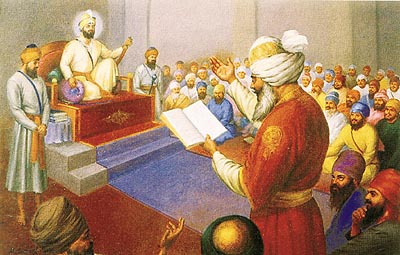Khalsa Panth
greatest gift to mankind
By Balraj
Madhok
IT is a happy coincidence that the
tercentenary of the foundation of the Khalsa Panth by
Guru Gobind Singh has come soon after the golden jubilee
of freedom of truncated Hindustan. The movement for
liberation of India from foreign rule did not begin in
1857. It began in the 8th century A.D. when Sindh and
Multan come under foreign Arab rule. West Punjab came
under Turkish rule around 1020 A.D. when Mehmood of
Gazani conqured Lahore and made it a part of his empire.
The rest of Punjab, Haryana and Delhi came under Turkish
rule after the defeat of the last Hindu king of Delhi,
Prithvi Raj Chauhan, in 1192 by the Turkish invador,
Shahabuddin Gauri. The Turkish rule was extended to the
rest of north India, except Assam and parts of south
India in the subsequent decades. But unlike Iran and
other countries conquered by Islamic Arabs and Turks,
India never fully submitted to the foreign rule. Struggle
for liberation was continued by the rulers and people of
India in some form or the other in different parts of the
country. Much has been written about this long struggle
for freedom in different parts of the country but not
much light has so far been thrown on the struggle for
liberation of Punjab from foreign rule in the period
prior to the rise of Maharaja Ranjit Singh. That makes
the foundation day of the Khalsa Panth on Baisakhi Day,
1699, at Anandpur not only a great event in the life of
the Sikhs and the Khalsa Panth but also a milestone in
the long struggle for freedom of the country.

Gobind Rai was the 10th
Guru of the Shishyas pronounced as Sikhs of Guru
Nanak Dev and his successor Gurus. The martyrdom of his
father and the Ninth Guru, Tegh Bahadur, influenced the
young mind of Gobind Rai. He then resolved to militarise
the Sikhs and prepare them for a prolonged struggle for
freedom of Desh and Dharm and put an end to the
repression and suppression of the Hindus in the name of
Islam. The creation of the Khalsa Panth was the first and
the most important step he took to achieve that
objective.
Sikhs from all over the
country met in a congregation at Anandpur on the Baisakhi
Day. Guru Gobind Rai who had performed a-year-long Yajna
at Naina Devi to propitiate goddess Shakti, gave a
stirring call to the congregation for volunteers who may
offer their heads to the goddess. The first to respond to
his call was Daya Ram Khatri of Lahore. After taking him
into a tent pitched nearby, the Guru with his
blood-dripping sword in his hand called for more
volunteers. Four others coming from different parts of
the country, including Swarashtra and Orissa and
belonging to lower castes, came forward one after the
other. They were all first ushered into that tent. They
were later brought out alive and presented to the
congregation. These five dedicated Sikhs were given the
name Khalsa or pure, and were projected as models and
described as Panj Piare. They were also declared
"Singhs’’ or lions and were given new
names ending with Singh. The Guru himself gave the lead
by changing his name from Gobind Rai to Gobind Singh.
Thus, the Khalsa panth created on this historic day was
to be the new army of lions, the true Kshatriyas, for the
protection of Hindu dharma and liberation of the
motherland. This is clear from the famous call of Guru
Gobind Singh: "Let the Khalsa Panth triumph all over
the world, so that Hindu dharma is awakened and
all falsehood is destroyed."
It is thus clear that
Khalsa Panth as conceived by Guru Gobind Singh was not a
new religion. It was to be the sword arm of the Hindu
people, particularly of those Hindus who had become
disciples of the Gurus. Every Khalsa was expected to be a
good Sikh and a good Hindu. The call to give at least one
son of the family for the Khalsa Panth was meant for all
Hindus and not for Sikhs alone. The Kshatriyas pronounced
as Khatris of Punjab took this call of the great
Guru most seriously.
The battle of Chamkaur
was the first battle fought by the Khalsa under the
leadership of Guru Gobind Singh himself. His two young
sons died fighting in that battle. His other two sons
fell into the hands of the Mughal subedar of Sirhind.
They were offered the choice of death or Islam. They
refused to become Muslims and were therefore entombed
alive in a wall. These four young sons of Guru Gobind
Singh were the noblest fighters for freedom and martyrs
for dharma.
Guru Gobind Singh could
not complete his mission. He had to leave Punjab in
search of allies. At Nanded in Maharashtra, he met a
Punjabi Kshtrya, Laxman Dev, who had become a Bairagi and
assumed the name Madhav Dass. Guru Gobind Singh inspired
him to go back to the path of duty of a true Kashtriya,
and carry on his mission in Punjab as his
"Banda".
Khalsa Panth is the
greatest gift of Guru Gobind Singh to his country and his
poeple for whom he lived and died. A saint, scholar,
warrior and visionary rolled into one. He was the
greatest Hindu, the most devoted shishya or Sikh
of Guru Nanak Dev and the first Khalsa of the age.
Banda Bairagi, also
called Banda Bahadur, carried out the mission entrusted
to him with great devotion, skill and ability. He put the
Mughals on the run and laid the foundation of independent
Punjab on which Maharaja Ranjit Singh later built the
independent kingdom of Punjab. It is unfortunate that his
role and achievements have not been given due importance
by Sikh historians and he has been virtually forgotten by
the Khalsa Panth.
|

